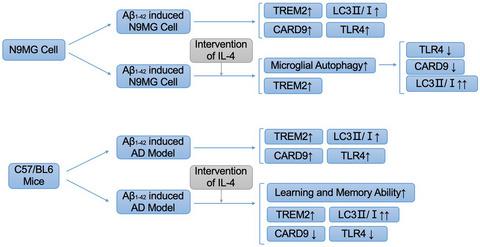Our official English website, www.x-mol.net, welcomes your
feedback! (Note: you will need to create a separate account there.)
Triggering receptor expressed on myeloid cells 2 activation downregulates toll-like receptor 4 expression and ameliorates cognitive impairment in the Aβ1-42 -induced Alzheimer's disease mouse model.
SYNAPSE ( IF 1.6 ) Pub Date : 2020-05-15 , DOI: 10.1002/syn.22161 Zhangjin Qin 1, 2 , Min Gu 2 , Jian Zhou 1 , Wenbo Zhang 1, 2 , Nan Zhao 1 , Yang Lü 2 , Weihua Yu 1
SYNAPSE ( IF 1.6 ) Pub Date : 2020-05-15 , DOI: 10.1002/syn.22161 Zhangjin Qin 1, 2 , Min Gu 2 , Jian Zhou 1 , Wenbo Zhang 1, 2 , Nan Zhao 1 , Yang Lü 2 , Weihua Yu 1
Affiliation

|
Increasing evidence suggests that changes in the triggering receptor expressed on myeloid cells 2 (TREM2) is closely correlated with the pathological development of Alzheimer's disease (AD). However, the biological function and related role of this change remain poorly understood. Higher TREM2 expression has been reported in the brain of AD patients than in normal controls. Here, levels of TREM2 gene and protein levels were observed to be higher in both cortex and hippocampus of the Aβ1‐42‐induced AD mice than in those of the wild type mice. Together with in vitro experimental data, we found that the anti‐inflammatory role of TREM2 was, to some extent, limited and potentially counteracted by the hyperactive toll‐like receptor 4 (TLR4) in the AD mice. In this context, Interleukin 4 (IL‐4), as an agonist of TREM2, was administered to the AD mice to persistently activate TREM2. Interestingly, TREM2 activation in IL‐4‐treated AD mice led to an elevation in lysosomes and microtubule‐associated protein 1 light chain 3 (LC3) II/I expression, demonstrating that the level of microglia autophagy was increased. Increased autophagy significantly downregulated the expression levels of caspase recruitment domain‐containing protein 9 (CARD9) and TLR4, potentially weakening the CARD9‐TLR4 pathway and suppressing the TLR4‐mediated pro‐inflammatory effect in IL‐4‐treated AD mice. Furthermore, data acquired from Morris water maze testing indicated that IL‐4 administration could ameliorate cognitive impairment in the AD mice. In conclusion, the findings from in vitro and in vivo experiments suggest that TREM2 might represent a potential drug target to treat neuroinflammation in AD.
中文翻译:

在 Aβ1-42 诱导的阿尔茨海默病小鼠模型中,髓样细胞 2 激活表达的触发受体下调 Toll 样受体 4 表达并改善认知障碍。
越来越多的证据表明,髓样细胞 2 (TREM2) 上表达的触发受体的变化与阿尔茨海默病 (AD) 的病理发展密切相关。然而,这种变化的生物学功能和相关作用仍然知之甚少。据报道,AD 患者脑中的 TREM2 表达高于正常对照。在这里,在 Aβ 1-42 的皮层和海马中观察到 TREM2 基因和蛋白质水平更高诱导的 AD 小鼠与野生型小鼠相比。结合体外实验数据,我们发现 TREM2 的抗炎作用在一定程度上受到 AD 小鼠过度活跃的 Toll 样受体 4(TLR4)的限制和潜在抵消。在这种情况下,白细胞介素 4 (IL-4) 作为 TREM2 的激动剂,被给予 AD 小鼠以持续激活 TREM2。有趣的是,IL-4 治疗的 AD 小鼠中的 TREM2 激活导致溶酶体和微管相关蛋白 1 轻链 3 (LC3) II/I 表达升高,表明小胶质细胞自噬水平增加。增加的自噬显着下调了含有半胱天冬酶募集结构域的蛋白 9(CARD9)和 TLR4 的表达水平,在 IL-4 治疗的 AD 小鼠中,可能会削弱 CARD9-TLR4 通路并抑制 TLR4 介导的促炎作用。此外,从 Morris 水迷宫测试获得的数据表明,IL-4 给药可以改善 AD 小鼠的认知障碍。总之,体外和体内实验的结果表明,TREM2 可能代表治疗 AD 神经炎症的潜在药物靶点。
更新日期:2020-05-15
中文翻译:

在 Aβ1-42 诱导的阿尔茨海默病小鼠模型中,髓样细胞 2 激活表达的触发受体下调 Toll 样受体 4 表达并改善认知障碍。
越来越多的证据表明,髓样细胞 2 (TREM2) 上表达的触发受体的变化与阿尔茨海默病 (AD) 的病理发展密切相关。然而,这种变化的生物学功能和相关作用仍然知之甚少。据报道,AD 患者脑中的 TREM2 表达高于正常对照。在这里,在 Aβ 1-42 的皮层和海马中观察到 TREM2 基因和蛋白质水平更高诱导的 AD 小鼠与野生型小鼠相比。结合体外实验数据,我们发现 TREM2 的抗炎作用在一定程度上受到 AD 小鼠过度活跃的 Toll 样受体 4(TLR4)的限制和潜在抵消。在这种情况下,白细胞介素 4 (IL-4) 作为 TREM2 的激动剂,被给予 AD 小鼠以持续激活 TREM2。有趣的是,IL-4 治疗的 AD 小鼠中的 TREM2 激活导致溶酶体和微管相关蛋白 1 轻链 3 (LC3) II/I 表达升高,表明小胶质细胞自噬水平增加。增加的自噬显着下调了含有半胱天冬酶募集结构域的蛋白 9(CARD9)和 TLR4 的表达水平,在 IL-4 治疗的 AD 小鼠中,可能会削弱 CARD9-TLR4 通路并抑制 TLR4 介导的促炎作用。此外,从 Morris 水迷宫测试获得的数据表明,IL-4 给药可以改善 AD 小鼠的认知障碍。总之,体外和体内实验的结果表明,TREM2 可能代表治疗 AD 神经炎症的潜在药物靶点。











































 京公网安备 11010802027423号
京公网安备 11010802027423号